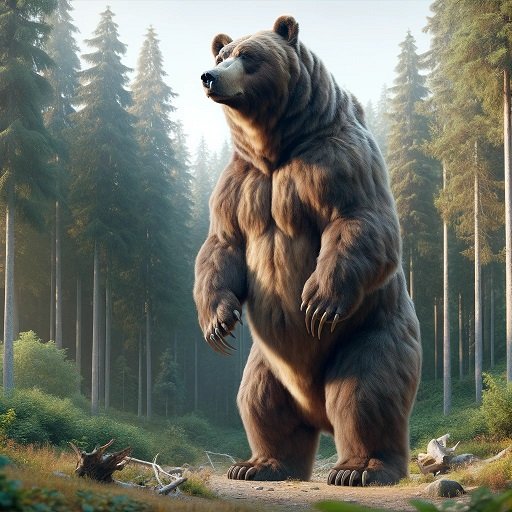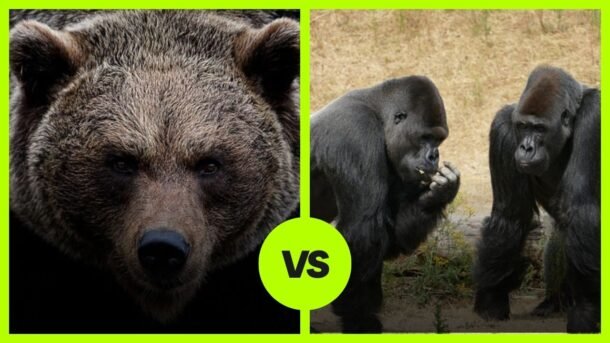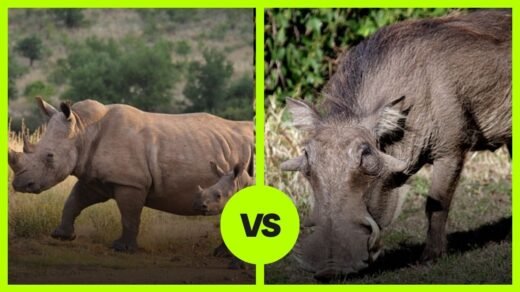Gorilla vs. Grizzly Bear is like watching two titans go head-to-head in a clash of epic proportions. It’s the sort of fight that makes you wish animals could have entrance music because you know it would be some real heart-pounding stuff.
The Heavyweights: Meet the Competitors
Grizzly Bears
Grizzly bears, known for their imposing size and strength, are omnivores with a diet that includes a mix of plant and animal matter. Their typical diet consists of:
- Plant-based foods: They commonly consume fleshy roots, fruits, berries, grasses, and forbs.
- Animal prey: Grizzlies are adept hunters and their animal prey includes fish (notably salmon), rodents like ground squirrels, and a variety of hoofed animals such as moose, elk, caribou, and deer. They are particularly skilled at catching the young of these hoofed species.
- Other food sources: They also eat carrion (dead animals) and can sometimes target domestic animals like cattle and sheep, which can lead to conflicts with humans.

Gorillas
Gorillas, primarily herbivorous, have diets that vary based on their species and habitat but generally consist of plant material:
- Mountain gorillas: Their diet mainly consists of foliage, including leaves, stems, pith, and shoots, with fruit making up a very small part of their diet. Mountain gorilla food is widely distributed, reducing competition for resources within their groups.
- Eastern lowland gorillas: They have a more diverse diet that changes with the seasons. Leaves and pith are commonly eaten, but fruits can comprise up to 25% of their diet. They also consume insects, with a preference for ants.
- Western lowland gorillas: They rely more on fruits and also consume termites and ants. Their diets necessitate longer daily travel and larger home ranges.

In terms of natural confrontations, gorillas are not typically aggressive or predatory animals. However, they do face threats from predators in the wild:
- Leopards: Leopards are capable of killing an adult gorilla, though they typically target western lowland gorillas and avoid the more robust silverback leaders, preferring younger individuals or offspring. Leopard attacks on gorillas are not common, but they do occur, especially when gorillas are unsuspecting or in vulnerable positions, like in their tree nests.
- Crocodiles: While less common, crocodiles are also potential predators of gorillas, though incidents involving these reptiles are relatively rare.
In conclusion, grizzly bears and gorillas lead very different lives in terms of their diets and the confrontations they face. Grizzlies, as omnivores, have a diverse diet that includes significant amounts of both plant and animal matter, and they are known to actively hunt for food. Gorillas, on the other hand, are primarily herbivorous, with their diet heavily skewed towards plant matter and occasional insect consumption. Their interactions with predators like leopards, while not frequent, highlight the dangers they face in their natural habitats.
Gorillas Combat Ability
Fighting Style
- Defensive Nature: Gorillas are generally not aggressive animals and will often try to avoid conflict. However, when they do fight, especially in situations involving the defense of their group, they can be formidable.
- Display Tactics: A typical gorilla confrontation starts with intimidating displays, like chest beating, loud hooting, and fake charges, to scare off potential threats without physical confrontation.
Offensive Tactics
- Strength in Arms: Gorillas have incredible upper body strength. If a physical confrontation occurs, they primarily use their powerful arms to deliver forceful slaps or punches.
- Biting: They also use their strong jaws and teeth as offensive tools, capable of inflicting significant damage.
Defensive Mechanisms
- Agility and Speed: Despite their size, gorillas are surprisingly agile, which they use to their advantage in avoiding attacks.
- Thick Skin: Their thick skin provides a certain level of protection against bites and scratches.
Grizzly Bears Attack
Fighting Style
- Aggressive Hunters: Grizzly bears are more aggressive compared to gorillas and are skilled hunters. They do not rely on intimidation tactics as much as gorillas but can roar or stand on their hind legs to appear more threatening.
Offensive Tactics
- Claws and Teeth: The grizzly’s primary weapons are its long, sharp claws and powerful jaws. The claws, up to 4 inches in length, are used for slashing and grabbing, capable of inflicting deep wounds.
- Biting: Grizzly bears have an extremely powerful bite, which they use to crush bones and grip their prey. This bite force is instrumental in killing or incapacitating their prey.
Defensive Mechanisms
- Thick Fur and Fat: Their thick fur and layers of fat provide a buffer against physical attacks.
- Size and Strength: The sheer size and strength of a grizzly bear are its best defense, as few animals can match them in a physical confrontation.
Finishing Prey
When it comes to finishing off their prey, grizzly bears typically use a combination of their physical strength and their natural weapons. They might knock down or immobilize prey with their powerful paws, then use their jaws to deliver a fatal bite, often targeting the neck or head of their prey. In the case of larger prey like moose or elk, they might bite and claw at the softer underbelly. Their approach can vary based on the size and nature of the prey.
Who Normally Hunts Whom?
Neither. Grizzlies are generally found in North America, while gorillas inhabit the forests of central Africa. But grizzlies do have a broad omnivorous diet that includes large mammals, so they’re more used to taking down creatures of significant size.
The Battleground: Where is This Throwdown Happening?
In a forest, both animals could use their respective climbing skills, but the grizzly would still likely dominate on the ground. In open terrain, the grizzly’s greater speed could make it hard for the gorilla to escape or dodge.
Drumroll, Please: Who Takes the Trophy?
Let’s lay down some percentages:
- Gorilla: 25%
- Grizzly Bear: 75%
The gorilla is strong and intelligent, but the grizzly bear has it beat in terms of sheer size, strength, and natural weapons. A gorilla would have to be exceptionally strategic and seize a rare opportunity to inflict damage, while the grizzly just has to do what grizzlies do best: use their brute strength and natural weapons to overpower their opponent.
For more thrilling animal showdowns, check out these articles on our website:
Explore the mighty Grizzly Bear vs Elephant: The Titan Showdown of Land Giants, a fascinating comparison of two of nature’s most formidable creatures.
Dive into Baboon vs Gorilla: A Primate Duel of Strength and Intelligence, contrasting the unique abilities of these two impressive primates.
Witness the clash of speed and strength in Cheetah vs Gorilla: The Clash of Speed and Brawn, an intriguing hypothetical battle between two vastly different animals.




